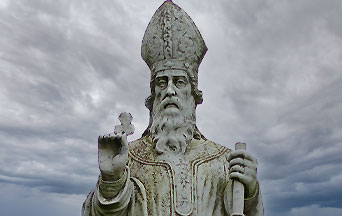
The loyalty of the Irish people to the Faith and to the Holy See is the great monument to Saint Patrick, their national Apostle. He was sent by Pope Celestine I and his labors in Ireland were accompanied and made fruitful by his extraordinary gifts of prayer and penance. In later years Ireland was known as the Island of Saints and Scholars.
Early life
Born in Kilpatrick, Scotland, Patrick’s parents were Calphurnius and Conchessa, the former from a high-ranking Roman family, holding an office in Britain. Conchessa was a close relative of the great Saint Martin of Tours.
At age sixteen, Irish raiders abducted Patrick and sold him into slavery to an Irish chieftain, Milchu, who used him as a shepherd.
In this solitude, the youth took solace in prayer, a habit that lit in him the fire of love of God—a fire that would later set ablaze the Catholic Faith in Ireland. During those years in captivity, he learned the Celtic language, and became acquainted with the customs of the Druids, a knowledge that would later be crucial to his apostolate. After six years, admonished by an angel, Patrick escaped and returned to Britain.
Priesthood, appointment to Ireland, and Bishopric
But now, his heart was set on dedicating his life to God in the priesthood. He studied in Tours and at the famed island-monastery of Lérins, and was later ordained by the great Saint Germain. Still, Patrick’s thoughts were with Ireland, and, from time to time, he had visions of Irish children who called to him, “…come back to Ireland, and walk once more among us.”
Eternal and Natural Law: The Foundation of Morals and Law
Pope Saint Celestine I, the great battler of heresies and devotee of the Blessed Virgin, dearly wished to conquer pagan Ireland for the Faith, and sent Bishop Palladius to the island. However, the Bishop was terrified of the fierce pagan chieftain, Wicklow, and soon gave up the enterprise. Hearing of the aborted mission, Saint Germain sent his disciple of 18 years, Patrick, to Rome to obtain permission to evangelize Ireland. After receiving the Papal blessing, the saint returned to the green isle, now to do battle with the forces of paganism.
Ireland
Patrick and his companions landed in Ireland probably around the year 433. They made their way north to the mouth of the River Boyne, where Patrick began to evangelize and performed his first miracle in defense of Our Lady and the Nativity of Jesus, converting many. At once the Druids were up in arms against the Christian intruder. One chieftain, Dilchu, tried to strike the saint with his sword, but his arm became petrified, and he joined Patrick and accepted instruction.
Patrick heard that in defiance to him, Leoghaire, the supreme monarch of Ireland, published an edict. On Easter Sunday, all households must extinguish their lights. Only at Tara, the place of the king, would a fire remain lit. All Druids and courtesans convened on Tara. They feared this messenger of Christ was beginning to win the Irish.
 Learn All About the Prophecies of Our Lady of Good Success About Our Times
Learn All About the Prophecies of Our Lady of Good Success About Our Times
The fearless man of God knew that this was his opportunity to, once and for all, plant the cross in Ireland. Patrick encamped on the hill opposite Tara, and lit a huge Paschal fire rivaling that of Leoghaire. In a panic, the Druids said to their leader, “O King, this fire which has been lighted in defiance of the royal edict will blaze forever in this land unless it be, this very night, extinguished.” A dispatch of Druids and armed men was sent to Patrick’s hill and repeated attempts made to extinguish the fire but to no avail. There were also snares and assaults prepared for Patrick, all of which, by divine protection, he dodged unscathed. His powerful prayer, Saint Patrick’s Breast-Plate is said to have been composed by him for his clash with paganism.
On Easter day, the missionary band, preceded by a youth carrying aloft the Holy Gospels, and followed by Saint Patrick wearing mitre and crosier, entered Tara. The Druids tried all their spells and incantations on the courageous company. After much effort, they finally succeeded in bringing darkness over the valley. Patrick prayed to the Lord, and the sun shone forth. Then, by demonic power, the Arch-Druid Lochru was lifted up in the air, striving to gain control over the saint. But at Patrick’s prayer, Lochru was dashed on the rocks.
Conversion of Ireland
On this day, Irish paganism was dealt a mortal blow. Beginning with the king, Saint Patrick began to evangelize the court, soon making a convert of one of the ministers, Dubhtach. It is on this occasion that Saint Patrick is said to have plucked a shamrock, three leaves on a single stem, to explain the mystery of the Holy Trinity to the assembled chieftains.
Science Confirms: Angels Took the House of Our Lady of Nazareth to Loreto
Saint Patrick spent his life working for the complete conversion of his beloved Irish. He particularly directed his apostolate to the chieftains, knowing that if the heads were conquered, their people would follow. And thus it happened that through his untiring evangelization, supported at times by great miracles, he conquered Ireland for the Holy Catholic Faith. Churches and monasteries arose, and religious orders were founded. Saint Patrick is said to have consecrated three hundred fifty bishops.
Saint Patrick died on March 17, 493. His remains were wrapped in a shroud by Saint Brigid. Bishops, clergy and faithful from all parts crowded around to offer due honor to the Father of their Faith. According to ancient records, for several days a light shone around his bier. The cathedral of Down was built on his grave.
IMAGE CREDIT Rob Hurson CC BY-SA 4.0
